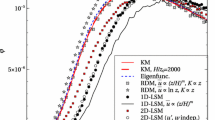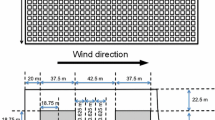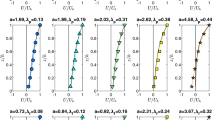Abstract
We investigated the flux footprints of receptors at different heights in the convective boundary layer (CBL). The footprints were derived using a forward Lagrangian stochastic (LS) method coupled with the turbulent fields from a large-eddy simulation model. Crosswind-integrated flux footprints shown as a function of upstream distances and sensor heights in the CBL were derived and compared using two LS particle simulation methods: an instantaneous area release and a crosswind linear continuous release. We found that for almost all sensor heights in the CBL, a major positive flux footprint zone was located close to the sensor upstream, while a weak negative footprint zone was located further upstream, with the transition band in non-dimensional upwind distances −X between approximately 1.5 and 2.0. Two-dimensional (2D) flux footprints for a point sensor were also simulated. For a sensor height of 0.158 z i, where z i is the CBL depth, we found that a major positive flux footprint zone followed a weak negative zone in the upstream direction. Two even weaker positive zones were also present on either side of the footprint axis, where the latter was rotated slightly from the geostrophic wind direction. Using CBL scaling, the 2D footprint result was normalized to show the source areas and was applied to real parameters obtained using aircraft-based measurements. With a mean wind speed in the CBL of U = 5.1 m s−1, convective velocity of w * = 1.37 m s−1, CBL depth of z i = 1,000 m, and flight track height of 159 m above the surface, the total flux footprint contribution zone was estimated to range from about 0.1 to 4.5 km upstream, in the case where the wind was perpendicular to the flight track. When the wind was parallel to the flight track, the total footprint contribution zone covered approximately 0.5 km on one side and 0.8 km on the other side of the flight track.
Similar content being viewed by others
References
Baldocchi D (1997) Flux footprints within and over forest canopies. Boundary-Layer Meteorol 85: 273–292
Barcza Z, Kern A, Haszpra L, Kljun N (2009) Spatial representativeness of tall tower eddy covariance measurements using remote sensing and footprint analysis. Agric For Meteorol 149(5): 795–807
Beyrich F, Richter SH, Weisensee U, Kohsiek W, Lohse H, de Bruin HAR, Foken Th, Göckede M, Berger F, Vogt R, Batchvarova E (2002) Experimental determination of turbulent fluxes over the heterogeneous LITFASS area: selected results from the LITFASS-98 experiment. Theor Appl Climatol 73: 19–34
Cai XH, Chen JY (1995) A large-eddy simulation model for convective boundary layer. Sci Atmos Sina 19: 415–421 (In Chinese)
Cai XH, Leclerc MY (2007) Forward-in-time and backward-in-time dispersion in the convective boundary layer: the concentration footprint. Boundary-Layer Meteorol 123: 201–218
Cai XH, Zhang R, Li Y (2006) A large eddy simulation and Lagrangian stochastic study of heavy particle dispersion in the convective boundary layer. Boundary-Layer Meteorol 120: 413–435
Cai XH, Peng GL, Guo XF, Leclerc MY (2008) Evaluation of backward and forward Lagrangian footprint models in the surface layer. Theor Appl Climatol 93: 207–223
Desjardins RL, MacPherson JI, Schuepp PH (2000) Aircraft-based flux sampling strategies. In: Meyers RA (eds) Encyclopedia of analytical chemistry. Wiley, Chichester, pp 3573–3588
Desjardins RL, Pattey E, Smith WN, Worth D, Grant B, Srinivasan R, MacPherson JI, Mauder M (2010) Multiscale estimates of N2O emissions from agricultural lands. Agric For Meteorol 150(6): 817–824
Estoque MA (1973) Numerical modelling of the planetary boundary layer. In: Haugen DA (eds) Workshop on micrometeorology. American Meteorological Society, Boston, MA, pp 217–270
Flesch TK (1996) The footprint for flux measurements, from backward Lagrangian stochastic models. Boundary-Layer Meteorol 78: 399–404
Foken T, Wichura B (1996) Tools for quality assessment of surface-based flux measurements. Agric For Meteorol 78: 83–105
Göckede M, Rebmann C, Foken T (2004) A combination of quality assessment tools for eddy covariance measurements with footprint modelling for the characterisation of complex sites. Agric For Meteorol 127: 175–188
Göckede M, Foken T, Aubinet M, Aurela M, Banza J, Bernhofer C, Bonnefond J-M, Brunet Y, Carrara A, Clement R, Dellwik E, Elbers J, Eugster W, Fuhrer J, Granier A, Grünwald T, Heinesch B, Janssens I, Knohl A, Koeble R, Laurila T, Longdoz B, Manca G, Marek M, Markkanen T, Mateus J, Matteucci G, Mauder M, Migliavacca M, Minerbi S, Moncrieff J, Montagnani L, Moors E, Ourcival J-M, Papale D, Pereira J, Pilegaard K, Pita G, Rambal S, Rebmann C, Rodrigues A, Rotenberg E, Sanz M, Sedlak P, Seufert G, Siebicke L, Soussana J, Valentini R, Vesala T, Verbeeck H, Yakir D (2008) Quality control of CarboEurope flux data—part I: coupling footprint analyses with flux data quality assessment to evaluate sites in forest ecosystems. Biogeosciences 5:433–450. http://www.biogeo-sciences.net/5/433/2008/
Guo XF, Cai XH (2005) Footprint characteristics for scalar concentration in the convective boundary layer. Adv Atmos Sci 22: 821–830
Horst TW, Weil JC (1992) Footprint estimation for scalar flux measurements in the atmospheric surface-layer. Boundary-Layer Meteorol 59: 279–296
Hsieh CI, Katul G, Chi T (2000) An approximate analytical model for footprint estimation of scalar fluxes in thermally stratified atmospheric flows. Adv Water Resour 23: 765–772
Kim SW, Moeng CH, Weil JC, Barth MC (2005) Lagrangian particle dispersion modeling of the fumigation process using large-eddy simulation. J Atmos Sci 62: 1932–1946
Kljun N, Rotach MW, Schmid HP (2002) A three-dimensional backward Lagrangian footprint model for a wide range of boundary-layer stratifications. Boundary-Layer Meteorol 103: 205–226
Kljun N, Kastner-Klein P, Fedorovich E, Rotach MW (2004) Evaluation of a Lagrangian footprint model using data from wind tunnel convective boundary layer. Agric For Meteorol 127: 189–201
Kormann R, Meixner FX (2001) An analytic footprint model for neutral stratification. Boundary-Layer Meteorol 99: 207–224
Kurbanmuradov O, Sabelfeld KK (2000) Stochastic Lagrangian models for turbulent dispersion in atmospheric boundary layer. Boundary-Layer Meteorol 97: 191–218
Lamb RG (1982) Diffusion in the convective boundary layer. In: Nieuwstadt FTM, van Dop H (eds) Atmospheric turbulence and air pollution modeling. Reidel Publishing Co., Dortrecht, pp 159–229
Leclerc MY, Thurtell GW (1990) Footprint prediction of scalar fluxes using a Markovian analysis. Boundary-Layer Meteorol 52: 247–258
Leclerc MY, Shen SH, Lamb B (1997) Observations and large-eddy simulation modeling of footprints in the lower convective boundary layer. J Geophys Res 102(D): 9323–9334
Markkanen T, Steinfeld G, Kljun N, Raasch S, Foken T (2009) Comparison of conventional Lagrangian stochastic footprint models against LES driven footprint estimates. Atmos Chem Phys 9: 5575–5586
Mason PJ (1989) Large eddy simulation of the convective atmospheric boundary layer. J Atmos Sci 46: 1492–1516
Mauder M, Desjardins RL, MacPherson I (2007) Scale analysis of airborne flux measurements over heterogeneous terrain in a boreal ecosystem. J Geophys Res 112: D13112
Moeng CH (1984) A large-eddy-simulation model for the study of planetary boundary-layer turbulence. J Atmos Sci 41: 2052–2062
Pasquill F (1972) Some aspects of boundary layer description. Q J Roy Meteorol Soc 98: 469–494
Aubinet M, Aubinet M, Kurbanmuradov O, Sabelfeld KK, Markkanen T, Vesala T (2000) Footprint analysis for measurement over a heterogeneous forest. Boundary-Layer Meteorol 97: 137–166
Sawford BL (1993) Recent development in the Lagrangian stochastic theory of turbulent dispersion. Boundary-Layer Meteorol 62: 197–215
Schmid HP (1994) Source areas for scalars and scalar fluxes. Boundary-Layer Meteorol 67: 293–318
Schmid HP (1997) Experimental design for flux measurements: matching scales of observations and fluxes. Agric For Meteorol 87: 179–200
Schmid HP (2002) Footprint modeling for vegetation atmosphere exchange studies: a review and perspective. Agric For Meteorol 113: 159–183
Schmid HP, Oke TR (1990) A model to estimate the source area contributing to turbulent exchange in the surface layer over patchy terrain. Q J Roy Meteorol Soc 116: 965–988
Schuepp PH, Leclerc MY, MacPherson JI, Desjardins RL (1990) Footprint prediction of scalar fluxes from analytical solutions of diffusion equation. Boundary-Layer Meteorol 50: 355–373
Sogachev A, Lloyd JJ (2004) Using a one-and-a-half order closure model of the atmospheric boundary layer for surface flux footprint estimation. Boundary-Layer Meteorol 112: 67–502
Sogachev A, Vesala T, Vesala T (2004) Flux footprints over complex terrain covered by heterogeneous forest. Agric For Meteorol 127: 143–158
Sogachev A, Panferov O, Gravenhorst G, Vesala T (2005) Numerical analysis of flux footprints for different landscapes. Theor Appl Climatol 80: 169–185
Steinfeld G, Raasch S, Markkanen T (2008) Footprints in homogeneously and heterogeneously driven boundary layers derived from a Lagrangian stochastic particle model embedded into large-eddy simulation. Boundary-Layer Meteorol 129: 225–248
Thomson DJ (1987) Criteria for the selection of stochastic models of particle trajectories in turbulent flows. J Fluid Mech 180: 529–556
Vesala T, Kljun N, Rinne J, Rinne J, Sogachev A, Markkanen T, Sabelfeld K, Foken Th, Leclerc MY (2008) Flux and concentration footprint modelling: state of the art. Environ Pollut 152: 653–666
Wang XQ (2004) Flux source area in the convective boundary layer derived by passive particles dispersion. MS Thesis, Peking University, 63 pp
Weil JC, Sullivan PP, Moeng C-H (2004) The use of large-eddy simulations in Lagrangian particle dispersion models. J Atmos Sci 61: 2877–2887
Willis GE, Deardorff JW (1976a) A laboratory model of diffusion into the convective planetary boundary. Q J Roy Meteorol Soc 102: 427–445
Willis GE, Deardorff JW (1976b) On the use of Taylor’s translation hypothesis for diffusion in the mixed layer. Q J Roy Meteorol Soc 102: 817–822
Wilson JD (2000) Trajectory models for heavy particles in atmospheric turbulence: comparison with observations. J Appl Meteorol 39: 1894–1912
Wilson JD, Flesch TK (1993) Flow boundaries in random-flight dispersion models: enforcing the well-mixed condition. J Appl Meteorol 32: 1695–1707
Wilson JD, Sawford BL (1996) Review of Lagrangian stochastic models for trajectories in the turbulent atmosphere. Boundary-Layer Meteorol 78: 191–210
Author information
Authors and Affiliations
Corresponding author
Rights and permissions
About this article
Cite this article
Cai, X., Chen, J. & Desjardins, R.L. Flux Footprints in the Convective Boundary Layer: Large-Eddy Simulation and Lagrangian Stochastic Modelling. Boundary-Layer Meteorol 137, 31–47 (2010). https://doi.org/10.1007/s10546-010-9519-7
Received:
Accepted:
Published:
Issue Date:
DOI: https://doi.org/10.1007/s10546-010-9519-7




